
_svg.png)

_svg.png)
TWICE AS FAR
SWISSAIR 111
CRASH INVESTIGATION
![]()
![]()
![]()
- THE INVESTIGATION -
This drawing is a map showing the coast of Nova Scotia
West of Halifax and centred on Peggy's Cove.
The yellow line provides the approximate route of Swissair 111
before its crash into the ocean Northeast of Pearl Island.
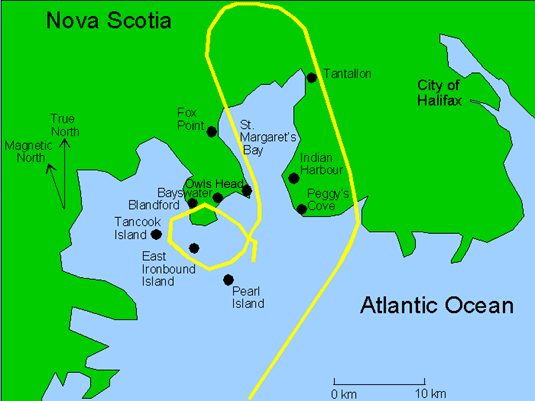
| Manufacturer |
McDonnell Douglas Corporation |
| Type and Model |
MD-11 |
| Year of Manufacture | 1991 |
| Serial Number (SN) |
48448 |
| Certificate of Airworthiness Issued | 28
July 1991 |
| Total Airframe Time (hours) | 36,041 |
| Engine Type (number of) |
Pratt & Whitney 4462 (3) |
| Maximum Take-Off Weight |
285 990 kilograms (kg) |
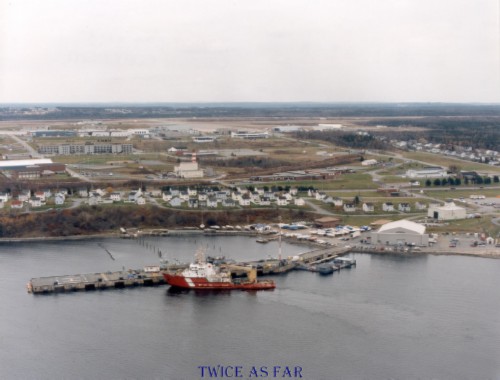
An aerial view of the military dock below the Shearwater base where the CCGS Earl Grey is arriving to offload debris from the crash site. The dock was maintained as a secure facility and RCMP, TSB, Coast Guard and DND personnel initially processed the cargo by washing it thoroughly at this location. The top half of the photo shows the Shearwater Airbase with its hangars and nine thousand foot airstrip.
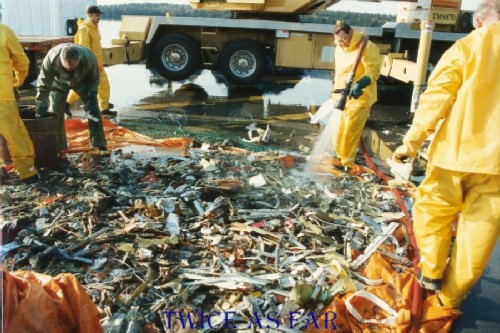
This picture shows part of the debris washing process. Having been brought up from the sea floor, it would frequently be covered in mud and sea debris. The salt residue was corrosive to the metal. However, as carefully undertaken as the whole process was, it would be ridiculous for anyone to say that valuable evidence was not lost somewhere in the process. Those opposing the potential for a criminal scenario ignored this fact. What's more, materials such as wires burnt bare of their insulation were in contact with all of this debris, thus creating a cross contamination problem.
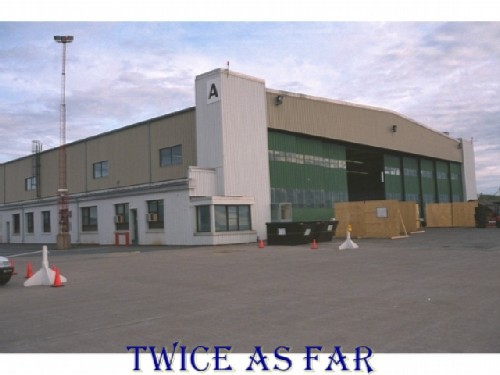
Hangar A, as one of the two hangars utilized in the file, is shown here. The photo shows the aircraft reconstruction hangar at the very early stages of the file before the white plastic annex was added to the area at the open hangar doors.
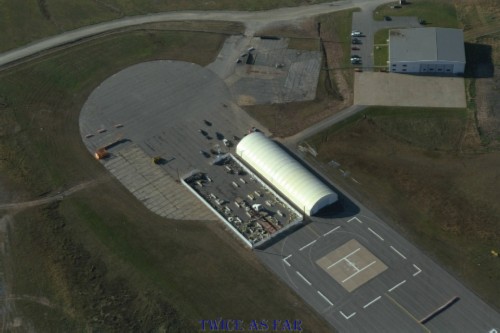
Hangar J and its outside storage area were constructed next to the Canadian Coast Guard hangar and offices. The large pieces of wreckage were stored in the outside pen area, and nearly 800 pallet-sized boxes of several million pieces of other debris were stored on racks inside the hangar.
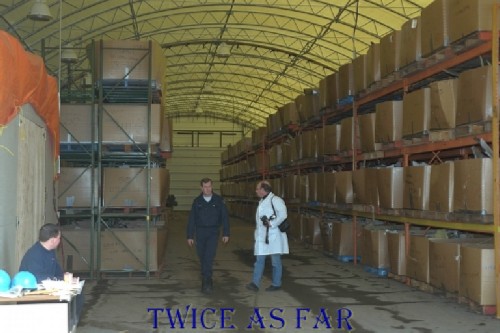
This photo is a view of the interior of Hangar J showing some of the nearly eight hundred tri-wall cardboard boxes containing various pieces of debris. Each box was given an exhibit number, and its location was recorded. Its contents were documented for later retrieval of specific parts or pieces. Cst. Andy Kerr is walking on the left with Cpl Joe Hines of Fredericton Identification Section on the right in the white lab coat. Andy oversaw the organization of this material.
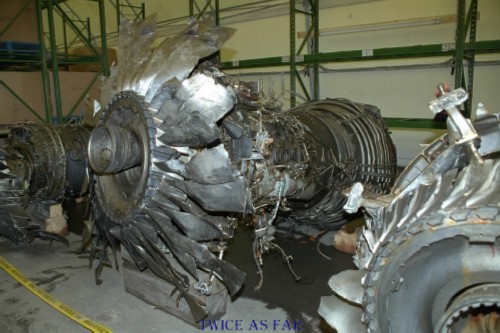
One of the three jet engines, each weighing several tons.
The engines were from Pratt & Whitney. After a thorough examination, they
were put away in storage Hangar J. The engine at photo centre is the #2 engine that
was located in the vertical stabilizer in the tail of the aircraft.
The fan blades suffered less damage than the blades of the
other engines because it was in what was called the 'windmill' mode.
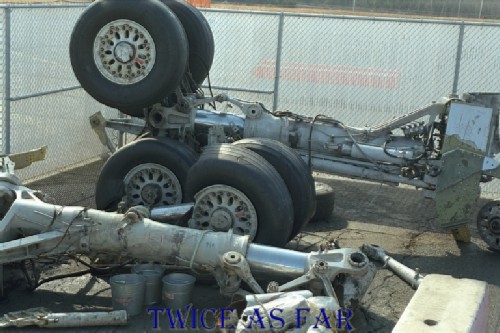
Some of the aircraft's undercarriage are shown in this photo. The tires are about four feet in diameter.

Shown here is part of the metal frame that held the undercarriage. It is made of steel alloys with sufficient strength to carry a 250-ton aircraft during a hard landing. This metal was sheared and torn apart like a piece of kindling.
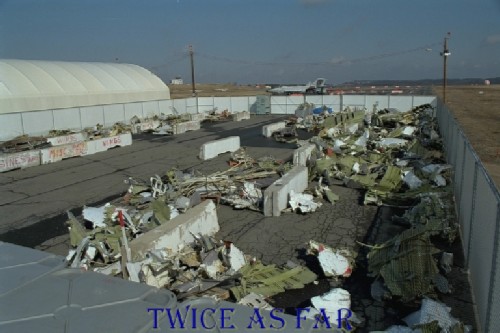
This photo shows some of the largest pieces of debris that were the wing pieces and rear fuselage areas.
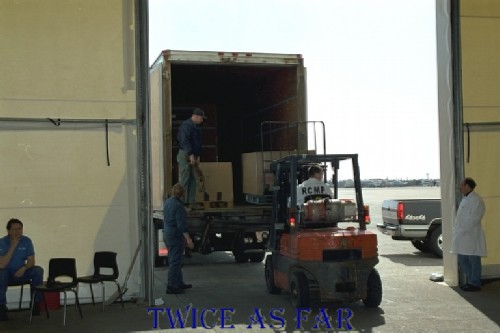
Tri-wall boxes on pallets are being loaded for transport to their storage position in Hangar J located just across the base. Some of the boxes contained many thousands of bits and pieces and weighed a thousand pounds or more.
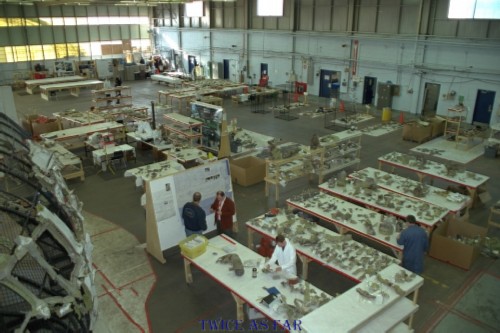
A view of the hangar floor about six months into the reconstruction stage. The reconstruction jig is present on the left of the photo and to the right are the tables of various parts, each in specific areas. The main doors to the hangar are in the far left background, and the sort line is located just in from those doors. The exhibiting line is located just to the right of that area. At the upper right corner of the reconstruction jig, left of photo centre is located the Identification position at the time of this picture. It later would move into one of the offices which are the blue doors across the upper right area of the picture.

This photo is a view of the hangar looking back on the location of the previous view. The reconstruction frame can be seen in the background with numerous tables and shelving units to hold the various pieces that are awaiting examination. In the lower left can be seen an area of cockpit carpet that has been set out for correct placement
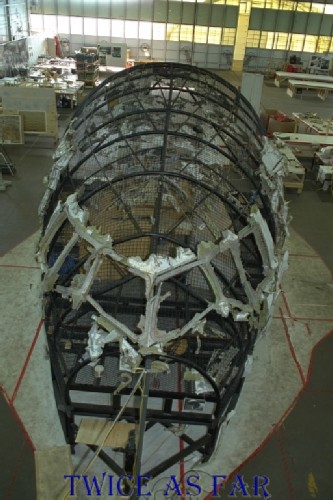
This high angle photo shows the main jig in a position to allow the addition of all the various pieces of debris. It was constructed by local members of the NS Dept. of Transportation and represents the cockpit area and the forward portion of the first class cabin. Since the fire was confined to the forward above cabin floor area, there was no need to include the rest of the aircraft.
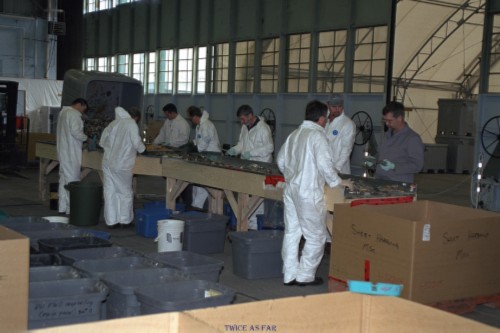
This photo shows the front of the hangar and the sorting table. Debris came into the hangar in large plastic tubs that were then emptied onto the sorting table, as shown here at the table's left end. TSB members along with Boeing and SR Technics people then tried to identify the various items as they were sorted. Also, present during the sorting was an RCMP Bomb Section member and a member of the RCMP's Crime Lab's Chemistry Section. Their purpose was to examine for evidence of explosives and any associated residue. This examination could never expect to locate proof of an incendiary device, something that would have been made of highly flammable and non-explosive materials.
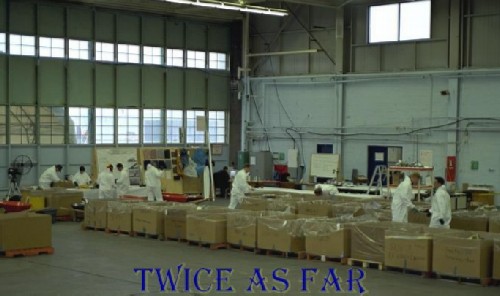
The sorting table is on the left in this photo, next to the main hangar doors. Extending to the right are the tri-wall boxes in which the man identified items were placed. Any item of specific importance was processed as an exhibit. That processing table was located against the wall in the right half of the photo and beyond the tri-wall boxes.
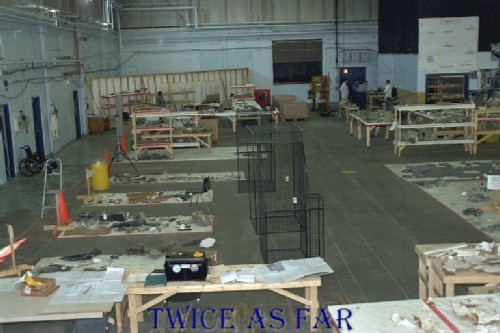
This photo shows a portion of the hangar floor where the forward galleys and lavatories are being reconstructed on metal frames. The floor area was very fluid in that this location at this time dealt with the galleys, but six months earlier the three jet engines had been here. Tables were portable and areas changed as the need arose.
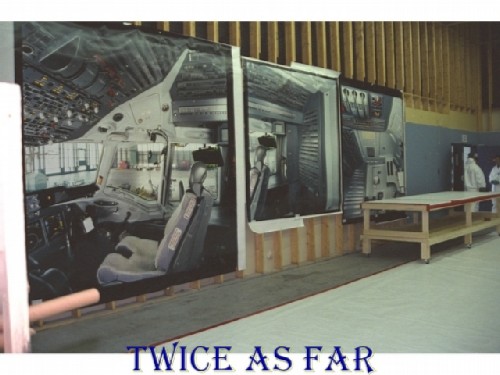
Some of the photographs that were taken by the Swiss photographer in Zurich to show the interiors views of the Swissair MD-11 aircraft are shown here. While the original aircraft manufacturer built a basic airplane, much like car manufacturers, each plane can have different equipment features and interior designs. Swissair's maintenance company, SR Technics, applied these additions to the aircraft at their main hangar facility in Zurich. While there were some basic equipment differences in the plane that had been supplied by the main manufacturer, what the passenger saw and sat in was applied by the airline and subsidiary companies. Therefore there was a requirement for photos of the interior of the Swissair MD-11 aircraft so that TSB and Boeing employees who had never been on the plane could visualize what the various pieces of interior equipment were.
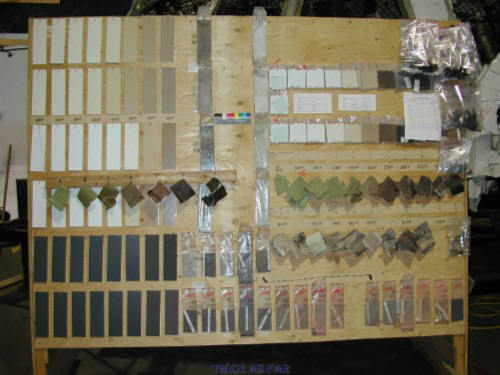
Part of the debris examination process included trying to determine how much heat each piece of debris had been exposed to and for how long. Paint on the metal surfaces is a forensic tool in that it discolours to specific tones depending on the quantity of heat and length of time of exposure. So metal strips and pieces of duct material were cut from non-burnt areas, and they were exposed to controlled temperatures for certain specific time periods. Each became what was called a time/temperature coupon and showed the discolouration that corresponds with those two factors. Where the paint has been burnt away, the discolouration of the actual metal then became the tool to determine the time and temperature of exposure.
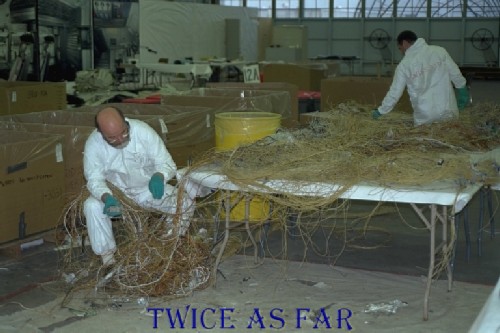
One of the TSB members was tasked with visually examining all two hundred and fifty miles of wiring that had been on the plane. This photo shows only a small portion of it, and this is mainly Kapton insulated wire. He was looking for any burn or abraded pieces, even tiny areas that could indicate a shorting of the wire against either another cable, a piece of equipment or the airframe.
* * * * * * * * * * * *
| ------------- NEXT PAGE ------------ |
| -------------- SITE MAP -------------- |
| ------------- TIME LINE ------------- |
| ------------ Home Page ------------ |
![]()
![]()
![]()
![]()